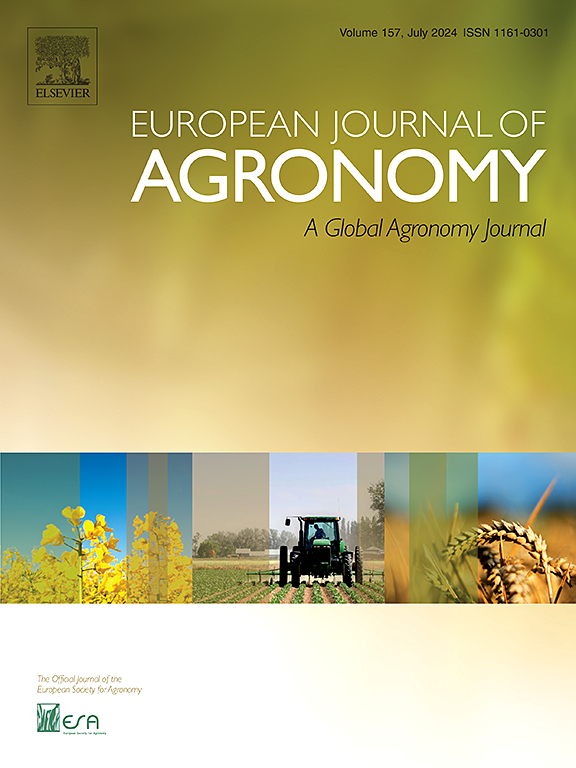Unraveling mechanisms of carbon enrichment via straw and biochar application to enhance soil fertility and improve maize yield
IF 4.5
1区 农林科学
Q1 AGRONOMY
引用次数: 0
Abstract
While straw and its derived biochar are established as effective soil amendments for carbon (C) sequestration, the divergent underlying mechanisms governing C enrichment through these materials and their corresponding agronomic implications remain poorly understood. In this four-year field study, stable C fractions such as microbial necromass carbon (MNC), humic C and aggregate-associated C were analyzed using biomarker techniques and fluorescence spectroscopy. Compared with no amendment, the application of straw and biochar significantly increased soil organic carbon (SOC) content and four-year average grain yield by 5.63 %–23.21 % and 10.52 %–18.47 %, respectively. Under equal C input rate, biochar enhanced stable C fractions more effectively than straw, including humic C (21.25 % increase), MNC (5.08 % increase), and aggregate-associated C. Regarding the molecular composition of humic acid (HA), biochar enhanced HA aromatization, whereas straw promoted its aliphatization. Furthermore, MNC was pivotal to SOC enrichment in straw-returned soil, while biochar application exhibited superior potential in promoting soil aggregation and achieving yield enhancement. These findings reveal contrasting mechanisms underlying straw-and biochar-induced SOC enrichment pathways: straw primarily enhances the pivotal contribution of microbial necromass to SOC, whereas biochar preferentially facilitates recalcitrant SOC formation via biochemical process and aggregate-mediated physical protection of SOC. Notably, the co-application of straw with a small amount of biochar demonstrated synergistic effects on both SOC enrichment (including MNC and macroaggregate-associated C) and maize yield enhancement. Therefore, optimized straw or biochar management strategies offer practical guidelines for enhancing SOC sequestration and improving crop productivity.
秸秆和生物炭增碳提高土壤肥力和玉米产量的机制
虽然秸秆及其衍生的生物炭已被确定为有效的碳(C)固存土壤改改剂,但通过这些材料富集碳的不同潜在机制及其相应的农艺意义仍然知之甚少。在这项为期四年的野外研究中,利用生物标志物技术和荧光光谱分析了稳定的碳组分,如微生物坏死碳(MNC)、腐殖质碳和聚集体相关碳。施用秸秆和生物炭可显著提高土壤有机碳(SOC)含量和4年平均粮食产量,增幅分别为5.63 % ~ 23.21 %和10.52 % ~ 18.47 %。在相同的C输入率下,生物炭比秸秆更有效地提高了腐植酸(21.25 %)、MNC(5.08 %)和团聚体相关C的稳定组分,在腐植酸(HA)的分子组成方面,生物炭增强了HA的芳构化,而秸秆促进了HA的脂肪化。秸秆还田土壤有机质富集的关键是秸秆还田,而生物炭在促进土壤团聚和提高产量方面表现出更强的潜力。这些发现揭示了秸秆和生物炭诱导的有机碳富集途径的不同机制:秸秆主要增强微生物坏死团对有机碳的关键贡献,而生物炭则通过生化过程和聚集体介导的有机碳物理保护优先促进顽固有机碳的形成。值得注意的是,秸秆与少量生物炭共施对土壤有机碳(包括MNC和大团聚体相关C)的富集和玉米产量的提高均有协同效应。因此,优化秸秆或生物炭管理策略为加强有机碳固存和提高作物生产力提供了实用指导。
本文章由计算机程序翻译,如有差异,请以英文原文为准。
求助全文
约1分钟内获得全文
求助全文
来源期刊

European Journal of Agronomy
农林科学-农艺学
CiteScore
8.30
自引率
7.70%
发文量
187
审稿时长
4.5 months
期刊介绍:
The European Journal of Agronomy, the official journal of the European Society for Agronomy, publishes original research papers reporting experimental and theoretical contributions to field-based agronomy and crop science. The journal will consider research at the field level for agricultural, horticultural and tree crops, that uses comprehensive and explanatory approaches. The EJA covers the following topics:
crop physiology
crop production and management including irrigation, fertilization and soil management
agroclimatology and modelling
plant-soil relationships
crop quality and post-harvest physiology
farming and cropping systems
agroecosystems and the environment
crop-weed interactions and management
organic farming
horticultural crops
papers from the European Society for Agronomy bi-annual meetings
In determining the suitability of submitted articles for publication, particular scrutiny is placed on the degree of novelty and significance of the research and the extent to which it adds to existing knowledge in agronomy.
 求助内容:
求助内容: 应助结果提醒方式:
应助结果提醒方式:


